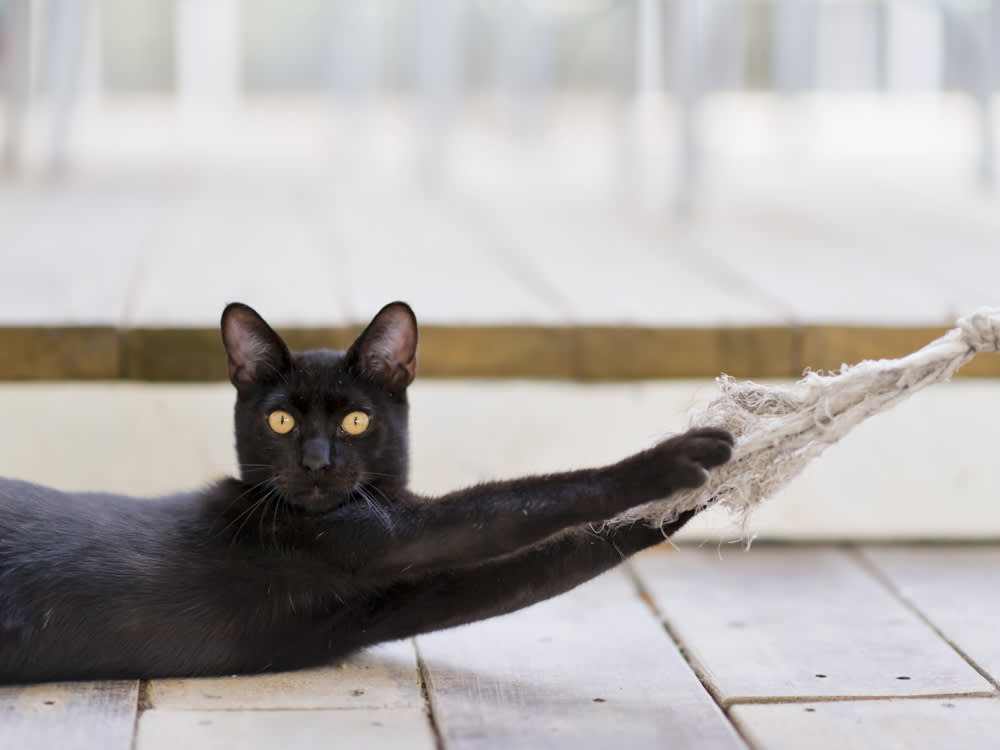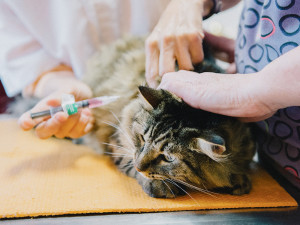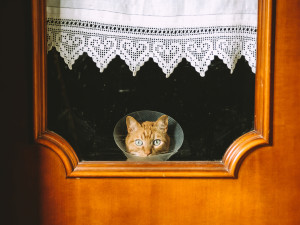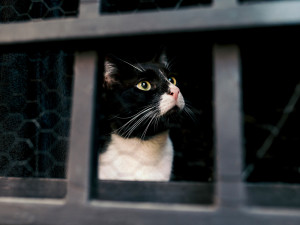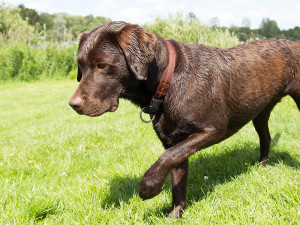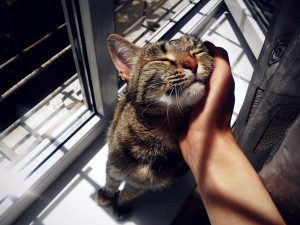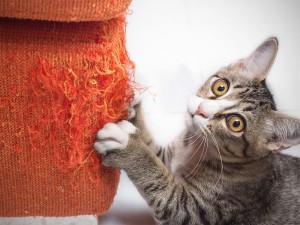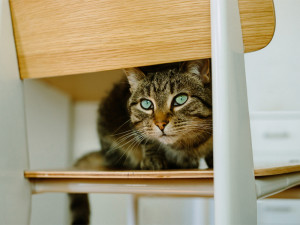It’s Seriously Uncool to Declaw Your Cat
A cat veterinarian explains why the inhumane surgery is no joke.
It’s a fact: Cats have claws. Claws that can ruin furniture and tear through human flesh like a knife through, well, human flesh. Does that justify the removal of said claws? Cats use their claws to hunt, but most indoor cats don’t hunt, so do they really even need them?
Honestly, just writing that last question makes my skin crawl. It’s like saying to a human: “You don’t run. Do you really need those feet?” It’s not a perfect analogy, I know, but given that declawing can actually hobble a cat for life, it’s much more appropriate than comparing the procedure to, say, an overzealous manicure.
A cat’s claws, after all, are not merely fingernails sharpened to a point. They grow from, and are thus attached to, the last bone on each of their toes, so their removal is essentially an amputation, by guillotine clipper or scalpel — broadly equivalent to cutting off the distal phalange of a human finger or toe. Could you live without the tips of your fingers and toes? Yes. Would you choose to? Of course not. Would your life be harder if you did? Most definitely.
And yet many people, even in 2024, still elect to declaw their cats. And vets across the country — who it seems reasonable to assume like animals and want to help them — still perform the procedure. But why? To find out, Kinship talked to Dr. Annette Louviere, a veterinarian specializing in cats and an active member of the American Association of Feline Practitionersopens in new tab. She’s also a mom to three cats of her own (Lenux, Frankie, and Odin) and a Chihuahua / Poodle mix named Izzy.
Editor’s note: In 2019, New York became the first state to make elective cat declaw surgery illegal, followed by the cities of Los Angeles, San Francisco, Denver, St. Louis, and Austin. More than 20 countries — including England, Germany, Spain, Australia, and New Zealand — have also long-banned the practice.
When did declawing first become a thing?
Declawing techniques were referenced in veterinary literature all the way back to the 1950s, but it wasn’t until the 1970s that it became common practice.
What are the potential negative side effects of declawing?
Aside from surgical complications related to the procedure, other primary concerns for declawing include both the immediate postoperative pain and the potential for chronic pain. Due to their stoic and subtle nature, pain can be difficult to decipher in cats. And so the true long-term physical effects of declawing cats are still being studied, but they include nerve damage, bone spurs, improper regrowth of claws, lameness, and back pain.
What do you mean “improper regrowth of claws”?
If a specific portion of the bone is not removed, then there is a chance that the claw will regrow. This regrowth can be deformed and may result in an abscess and pain at the site.
What about psychological side effects?
Unfortunately, there isn’t a short answer for this question. Numerous studies have made links between declawing cats and an increase in undesirable behaviors — including inappropriate elimination, aggression, and biting — while alternative studies have indicated no significant difference in behavior problems of clawed cats versus those that have been declawed. Due to this conflicting information regarding the psychological effects of declawing cats, it’s an area which requires further research to truly understand (and that’s partly why there’s so much controversy still surrounding the procedure).
Why do so many vets still do it?
In some scenarios, declawing may be viewed as an alternative to placing the cat outdoors, rehoming (or surrendering them to shelter), or even euthanasia. Advocates for the procedure have also cited surveys where the pet parent reported an improved relationship with their cat as a result of declawing.
I bet the cat wouldn’t be so chill if they knew their parent was the one who took their claws. Or does declawing somehow make cats more passive? Less aggressive?
No. Declawing will not address or stop the cat’s aggression and, in some scenarios, risks making the situation worse.
That’s always been my experience with declawed cats. They seem to feel less safe and lash out more.
Aggression cases should be handled through a veterinarian or board-certified veterinary behaviorist before any permanent decisions are made. And if it’s a sudden temperament change, then a deeper dive into medical causes for the aggression should be a part of the conversation.
Declawing must still be taught in veterinary schools, though, right?
Actually, these days many vet schools don’t teach declawing techniques; however, the ethical discussion around the procedure is still often addressed.
Ethical discussion?
For instance, when I was in school, our ethics conversation highlighted the two sides of the controversy regarding declawing so you, as a soon-to-be veterinarian, could make a decision that best followed your morals. Included in the conversation was the real world scenario for companion animal veterinarians practicing at hospitals where they would have to decide on whether or not to perform elective declaws on cats, and how to approach the matter in a constructive manner when your morals don’t align with the hospital’s guidelines. Ethics conversations such as these typically include other sensitive veterinary topics, like ear cropping in dogs.
Another horror, in my opinion. Have you ever declawed a cat?
I have performed a handful of onychectomies (declaw procedures) during my clinical career. It’s not a procedure to take lightly, and I strongly advocate for multimodal pain management along with strict post-surgical instructions for these cases. Also, it’s best to understand the reasoning behind the request. I do not view declawing as an option to address undesirable scratching, such as to protect furniture. However, I will consider it for medical reasons — whether for the cat or, on rare occasions, the pet parent.
What kind of medical reasons?
To remove a tumor or if the toe/claw is damaged beyond repair. Additionally, it’s been described in severely painful cases of paronychia (inflammation of the soft tissues around the nail) that cannot be controlled by medical interventions. In cases like these, however, the procedure involved removing the claw from a specific toe (or toes), rather than the whole foot.
That makes sense (performing the procedure as part of a necessary medical intervention), but are there instances where it makes medical sense to remove all the claws? For instance, a friend of a friend had her hairless cats declawed, claiming it was necessary for hairless cats, otherwise they would scratch themselves bloody. Is there any truth to that?
The simple answer is no. Scratching is a very normal part of a kitty’s grooming routine, hairless or not. If scratching is creating sores then there’s likely an underlying medical cause, like a skin infection, which should be addressed.
I knew it. How would declawing a cat potentially serve the medical needs of the pet parent?
I haven’t come across the need to perform a declaw procedure due to a pet parent’s medical history, but it’s one of the ethics points to consider regarding declawing. These would be very rare cases and include people strongly bonded to their cat who are immunosuppressed or an elderly individual receiving blood thinners. Even in these cases, the decision regarding declawing isn’t clear-cut and should include a consultation between the veterinarian and pet parent(s).
Are there alternatives to declawing?
There is an alternative procedure called deep digital flexor tendonectomy, but like declawing, it is not without controversy or potentially serious complications. It involves cutting tendons to prevent the cat from protruding its claws. The claws remain, but the cat can no longer extend them because this would be done through flexing the tendon. This means the cat isn’t able to bend the ends of their toes or make grasping motions.
But despite not being “used,” the claws will continue to grow. And they grow in a downward circular fashion, so it’s highly important the claws are clipped to prevent the nail growing into the soft foot pads underneath. This makes routine clipping and maintenance of the claws required throughout the cat’s lifetime. Also, there’s still postoperative pain and the potential for complications — like infection, lameness, and brittle nails — associated with this elective procedure.
What about non-surgical alternatives?
Absolutely! There are several great alternatives to declawing that should be brought into the conversation long before something as permanent as surgery is considered — if it is considered at all.
Adding deterrents to the furniture surfaces, like safe double-sided tape or anti-scratch tape.
Introducing appropriate scratching surfaces in these areas (it’s also worth noting that cats can have scratching preferences including location, surface type, and surface angle).
Applying nail caps, such as Soft Paws.
Once initial steps are taken, the focus can shift to providing environmental enrichment for the cat and redirecting the undesired scratching to a more desirable location (aka re-training where the cat scratches).
Because cats need to scratch, right? It’s, like, part of who they are.
Yes. Scratching is a perfectly natural behavior for cats. It functions as a means of grooming by removing old layers of the claw, serves as communication by leaving behind their scent, and facilitates full body stretching. I mean, who doesn’t enjoy a nice stretch after a nap?
